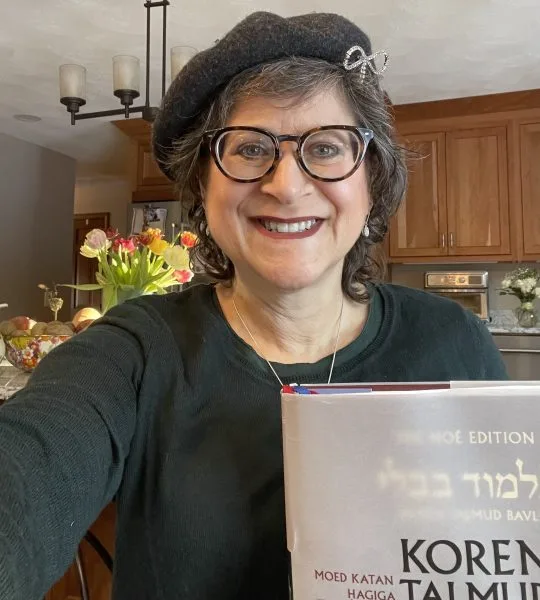Eruvin 6
מִצִּידּוֹ — בְּעֶשֶׂר, מֵרֹאשׁוֹ — בְּאַרְבָּעָה.
if it was breached from its side, the side wall of the alleyway, carrying within the alleyway is prohibited if the breach is ten cubits wide. But if it was breached from its front, the wall that faces the public domain, carrying within the alleyway is prohibited even if the breach is only four handbreadths wide.
מַאי שְׁנָא מִצִּידּוֹ בְּעֶשֶׂר — דְּאָמַר פִּתְחָא הוּא, מֵרֹאשׁוֹ נָמֵי נֵימָא פִּתְחָא הוּא!
The Gemara poses a question: What is the difference such that carrying is prohibited due to a breach from the side only if the breach is ten cubits? This is because you say that up to ten cubits it is deemed an entrance. If the breach is in the front, let us also say it is an entrance, and carrying should be permitted if the breach is less than ten cubits.
אָמַר רַב הוּנָא בְּרֵיהּ דְּרַב יְהוֹשֻׁעַ: כְּגוֹן שֶׁנִּפְרַץ בְּקֶרֶן זָוִית, דְּפִתְחָא בְּקֶרֶן זָוִית לָא עָבְדִי אִינָשֵׁי.
Rav Huna, son of Rav Yehoshua, said: We are dealing with a case where the breach is in a corner. Since people do not make an entrance in a corner, a breach of this kind cannot be viewed as an entrance, and if the breach is larger than four handbreadths it must be sealed.
וְרַב הוּנָא אָמַר: אֶחָד זֶה וְאֶחָד זֶה בְּאַרְבָּעָה. וְכֵן אֲמַר לֵיהּ רַב הוּנָא לְרַב חָנָן בַּר רָבָא: לָא תִּפְלוֹג עִלַּאי דְּרַב אִיקְּלַע לְדַמְחַרְיָא וַעֲבַד עוֹבָדָא כְּווֹתִי. אֲמַר לֵיהּ: רַב בִּקְעָה מָצָא וְגָדַר בָּהּ גָּדֵר.
Rav Huna disagreed with Rav Ḥanin bar Rava and said: There is no distinction between the side and the front, for in both this case and that, a breach of up to four handbreadths is allowed. And so Rav Huna said to Rav Ḥanan bar Rava: Do not dispute me, as Rav himself arrived at a place called Damḥarya and performed an action, i.e., issued a practical ruling, in accordance with my opinion. Rav Ḥanan bar Rava said in response to him: No proof can be brought from that incident, for in that case Rav found an unguarded valley and fenced it in, i.e., Rav saw the need to add a safeguard and was therefore stringent in this case. His ruling, however, was not generally applied.
אָמַר רַב נַחְמָן בַּר יִצְחָק: כְּווֹתֵיהּ דְּרַב הוּנָא מִסְתַּבְּרָא, דְּאִיתְּמַר: מָבוֹי עָקוֹם — רַב אָמַר: תּוֹרָתוֹ כִּמְפוּלָּשׁ. וּשְׁמוּאֵל אָמַר: תּוֹרָתוֹ כְּסָתוּם.
Rav Naḥman bar Yitzḥak said: Rav Huna’s opinion stands to reason, as it was stated that the amora’im disagree about the following issue: With regard to a crooked, L-shaped alleyway that opens onto the public domain at both ends, Rav said: Its law is like that of an alleyway that is open on two opposite sides, and it must be treated in a manner suitable for such an alleyway, i.e., an opening in the form of a doorway must be constructed at both ends, or else such an opening must be constructed at the point where the two arms of the alleyway meet and a side post or a cross beam must be placed at each end. And Shmuel said: Its law is like that of an alleyway that is closed on one side, and all that is necessary is a side post or a cross beam at each end.
בְּמַאי עָסְקִינַן? אִילֵימָא בְּיוֹתֵר מֵעֶשֶׂר — בְּהָא לֵימָא שְׁמוּאֵל תּוֹרָתוֹ כְּסָתוּם?
The Gemara clarifies the particular circumstances of the case: With what are we dealing? If you say that the width of the alleyway at the point of the turn is more than ten cubits wide, in this case, would Shmuel say that its law is like that of an alleyway that is closed on one side? With an opening of that size, it must be considered like an alleyway that is open on both ends.
אֶלָּא לָאו בְּעֶשֶׂר, וְקָאָמַר רַב תּוֹרָתוֹ כִּמְפוּלָּשׁ, אַלְמָא פִּירְצַת מָבוֹי מִצִּידּוֹ בְּאַרְבָּעָה!
Rather, are we not dealing with a case where the width of the alleyway at the point of the turn is ten cubits or less, and Rav nonetheless said that the law of such an alleyway is like that of an alleyway that is open on both ends. Apparently, a breach in the side wall of an alleyway renders it prohibited to carry even if it is only four handbreadths wide, in accordance with the opinion of Rav Huna.
וְרַב חָנָן בַּר רָבָא, שָׁאנֵי הָתָם דְּקָא בָּקְעִי בַּהּ רַבִּים.
And Rav Ḥanan bar Rava argues that the cases cannot be compared: It is different there, in the case of the L-shaped alleyway, for many people cross through the opening from one arm to the other. Since in practice the alleyway is open to regular traffic, the ruling is stringent even with regard to a small breach.
מִכְּלָל דְּרַב הוּנָא סָבַר אַף עַל גַּב דְּלָא בָּקְעִי בַּהּ רַבִּים, מַאי שְׁנָא מִדְּרַבִּי אַמֵּי וְרַבִּי אַסִּי?
The Gemara asks: Can it be inferred from this that Rav Huna holds that even if many people do not cross through the opening, a breach of four handbreadths still prohibits carrying? What is the difference between this case and the case of the ruling of Rabbi Ami and Rabbi Asi cited earlier, that an upright board of four handbreadths suffices in order to allow a breach of up to ten cubits?
הָתָם דְּאִיכָּא גִּידּוּדֵי, הָכָא דְּלֵיכָּא גִּידּוּדֵי.
The Gemara answers: There, there are remnants of a wall that render it difficult to pass through the breach, and therefore that breach does not annul the partitions. However, here, there are no remnants of a wall.
תָּנוּ רַבָּנַן: כֵּיצַד מְעָרְבִין דֶּרֶךְ רְשׁוּת הָרַבִּים? עוֹשֶׂה צוּרַת הַפֶּתַח מִכָּאן, וְלֶחִי וְקוֹרָה מִכָּאן. חֲנַנְיָה אוֹמֵר: בֵּית שַׁמַּאי אוֹמְרִים: עוֹשֶׂה דֶּלֶת מִכָּאן וְדֶלֶת מִכָּאן וּכְשֶׁהוּא יוֹצֵא וְנִכְנָס נוֹעֵל. בֵּית הִלֵּל אוֹמְרִים: עוֹשֶׂה דֶּלֶת מִכָּאן, וְלֶחִי וְקוֹרָה מִכָּאן.
The Sages taught in a baraita: How does one render a public thoroughfare fit for carrying by means of an eiruv? He constructs an opening in the form of a doorway from here, on one side of the thoroughfare, and a side post or a cross beam from here, on the other side. Ḥananya disagrees and says: This is the subject of an early dispute between tanna’im, for Beit Shammai say: He constructs a door from here, on one side, and a door from here, on the other side, and when he exits and enters, he must lock the door. It is not sufficient to construct a symbolic door; rather, there must be a door that actually closes. And Beit Hillel say: He constructs a door from here, on one side, and a side post or a cross beam from here, on the other side.
וּרְשׁוּת הָרַבִּים מִי מִיעָרְבָא?! וְהָתַנְיָא: יָתֵר עַל כֵּן אָמַר רַבִּי יְהוּדָה,
The Gemara raises a fundamental question: Can a public domain be rendered fit for carrying by means of an eiruv? Wasn’t it taught in a baraita: Furthermore, Rabbi Yehuda said:
מִי שֶׁהָיוּ לוֹ שְׁנֵי בָתִּים מִשְּׁנֵי צִידֵּי רְשׁוּת הָרַבִּים, עוֹשֶׂה לֶחִי מִכָּאן וְלֶחִי מִכָּאן, אוֹ קוֹרָה מִכָּאן וְקוֹרָה מִכָּאן, וְנוֹשֵׂא וְנוֹתֵן בָּאֶמְצַע. אָמְרוּ לוֹ: אֵין מְעָרְבִין רְשׁוּת הָרַבִּים בְּכָךְ.
One who has two houses opposite each other on the two sides of the public domain, and he wishes to carry from one house to the other on Shabbat via the public domain, he may place a side post from here, on one side of one of the houses, and an additional side post from here, on the other side. Alternatively, he may place a cross beam from here, from one end of one house, and an additional cross beam from here, from the other side of the house, and then he may carry objects and place them in the area between them, for in this manner he turns the middle area into a private domain. The Rabbis said to him: One cannot render a public domain fit for carrying by means of an eiruv in this manner. Apparently, there is no way to establish an absolute public domain fit for carrying by means of an eiruv.
וְכִי תֵּימָא בְּכָךְ הוּא דְּלָא מִיעָרְבָא, הָא בִּדְלָתוֹת מִיעָרְבָא, וְהָאָמַר רַבָּה בַּר בַּר חָנָה אָמַר רַבִּי יוֹחָנָן: יְרוּשָׁלַיִם, אִילְמָלֵא דַּלְתוֹתֶיהָ נִנְעָלוֹת בַּלַּיְלָה — חַיָּיבִין עָלֶיהָ מִשּׁוּם רְשׁוּת הָרַבִּים!
The Gemara questions its previous conclusion: And if you say that it is only in this manner, by way of a side post or a cross beam, that a public domain cannot be rendered fit for carrying, but by means of doors it can be rendered fit for carrying. But this is not true, as didn’t Rabba bar bar Ḥana say that Rabbi Yoḥanan said: With regard to Jerusalem, were it not for the fact that its doors are locked at night, one would be liable for carrying in it on Shabbat, because its thoroughfares are regarded as a public domain? This shows that the presence of a door is not sufficient to render it permitted to carry in a public domain; rather, the door must actually be locked.
וְאָמַר עוּלָּא: הָנֵי אֲבוּלֵּי דְמָחוֹזָא אִילְמָלֵא דַּלְתוֹתֵיהֶן נִנְעָלוֹת — חַיָּיבִין עֲלֵיהֶן מִשּׁוּם רְשׁוּת הָרַבִּים.
And similarly, Ulla stated: With regard to the city entrances [abbulei] of Meḥoza, which meet the criteria for a public domain, were it not for the fact that their doors are locked, one would be liable for carrying in them, because they are regarded as a public domain. Apparently, without the actual locking of doors it is impossible to establish a public domain fit for carrying by means of the symbolic partitions of a side post or a cross beam. If so, how can the Sages in the baraita argue about how to establish a public domain fit for carrying?
אָמַר רַב יְהוּדָה, הָכִי קָאָמַר: כֵּיצַד מְעָרְבִין מְבוֹאוֹת הַמְפוּלָּשִׁין לִרְשׁוּת הָרַבִּים, עוֹשֶׂה צוּרַת הַפֶּתַח מִכָּאן וְלֶחִי וְקוֹרָה מִכָּאן.
Rather, Rav Yehuda said: The wording of the baraita must be emended so that this is what it says: How does one render alleyways that are not themselves public domains but are open on two opposite sides into the public domain fit for carrying by means of an eiruv? He constructs an opening in the form of a doorway from here, on one side of the alleyway, and a side post or a cross beam from here, on the other side.
אִיתְּמַר. רַב אָמַר: הִילְכְתָא כְּתַנָּא קַמָּא. וּשְׁמוּאֵל אָמַר: הֲלָכָה כַּחֲנַנְיָה.
It was stated that the amora’im differed on how the halakha is to be decided with regard to this issue. Rav said: The halakha is in accordance with the opinion of the anonymous first tanna of the baraita, and it is sufficient to have the form of a doorway on one side and a side post or cross beam on the other side in order to render it permitted to carry in an alleyway that is open on two opposite sides to the public domain. And Shmuel says: The halakha is in accordance with the opinion of Ḥananya, following the position of Beit Hillel, who also require a door on one side.
אִיבַּעְיָא לְהוּ: לַחֲנַנְיָה אַלִּיבָּא דְּבֵית הִלֵּל צָרִיךְ לִנְעוֹל, אוֹ אֵין צָרִיךְ לִנְעוֹל? תָּא שְׁמַע, דְּאָמַר רַב יְהוּדָה אָמַר שְׁמוּאֵל: אֵינוֹ צָרִיךְ לִנְעוֹל. וְכֵן אָמַר רַב מַתְנָה אָמַר שְׁמוּאֵל: אֵינוֹ צָרִיךְ לִנְעוֹל. אִיכָּא דְאָמְרִי אָמַר רַב מַתְנָה: בְּדִידִי הֲוָה עוֹבָדָא, וְאָמַר לִי שְׁמוּאֵל: אֵין צָרִיךְ לִנְעוֹל.
A dilemma was raised before the Sages concerning the position of Beit Hillel: According to Ḥananya, in accordance with the opinion of Beit Hillel, must this door be locked or need it not be locked? Come and hear a proof from that which Rav Yehuda said that Shmuel said, who, as mentioned earlier, rules in accordance with Beit Hillel: The door need not be locked. And similarly, Rav Mattana said that Shmuel said: The door need not be locked. Some say that Rav Mattana said: A case involving this very issue happened to me, and Shmuel said to me: The door need not be locked.
בְּעוֹ מִינֵּיהּ מֵרַב עָנָן: צָרִיךְ לִנְעוֹל אוֹ אֵין צָרִיךְ לִנְעוֹל? אֲמַר לְהוּ: תָּא חֲזִי הָנֵי אֲבוּלֵּי דִּנְהַרְדָּעָא דְּטִימָן עַד פַּלְגַיְיהוּ בְּעַפְרָא, וְעָיֵיל וְנָפֵיק מָר שְׁמוּאֵל, וְלָא אֲמַר לְהוּ וְלָא מִידֵּי.
They raised a dilemma before Rav Anan with regard to this issue: Need the door be locked or need it not be locked? He said to them: Come and see these city entrances of Neharde’a that open on two opposite sides into the public domain, the gateways of which were filled up halfway with earth, so that the doors themselves could not possibly be locked. Mar Shmuel regularly goes in and out through them, but has never said anything to the people of Neharde’a about them. This shows that it is not necessary for the doors to be locked.
אָמַר רַב כָּהֲנָא: הָנָךְ מְגוּפוֹת הֲוַאי.
Rav Kahana rejected this proof and said: Those doors in Neharde’a were partially blocked, and therefore there was no need to lock them, but in general, the door of an alleyway that opens on both sides into the public domain must be locked.
כִּי אֲתָא רַב נַחְמָן אָמַר: פַּנְּיוּהּ לְעַפְרַיְיהוּ. לֵימָא קָסָבַר רַב נַחְמָן: צָרִיךְ לִנְעוֹל? לָא, כֵּיוָן דִּרְאוּיוֹת לִנְעוֹל, אַף עַל פִּי שֶׁאֵין נִנְעָלוֹת.
The Gemara relates that when Rav Naḥman came to Neharde’a, he said: Clear away the earth, so that the doors can be locked. The Gemara attempts to understand Rav Naḥman’s instruction: Let us say that Rav Naḥman holds that the door of an alleyway that is open on two opposite sides must be locked. The Gemara explains: No, this is not proof. In order for carrying to be permitted in such an alleyway, it is enough that the doors be fit to be locked, even if they are not actually locked.
הָהוּא מָבוֹי עָקוֹם דַּהֲוָה בִּנְהַרְדְּעָא, רְמֵי עֲלֵיהּ חוּמְרֵיהּ דְּרַב וְחוּמְרֵיהּ דִּשְׁמוּאֵל, וְאַצְרְכוּהוּ דְּלָתוֹת. חוּמְרֵיהּ דְּרַב — דְּאָמַר: תּוֹרָתוֹ כִּמְפוּלָּשׁ. וְהָאָמַר רַב הֲלָכָה כְּתַנָּא קַמָּא?!
The Gemara describes a certain crooked, L-shaped alleyway that was in Neharde’a, upon which they imposed the stringency of Rav and the stringency of Shmuel, and required it to have doors. The Gemara attempts to understand this ruling: The stringency of Rav, namely, that which he said, that an L-shaped alleyway is regarded like an alleyway that is open on two opposite sides. But this is difficult, for didn’t Rav say that the law follows the anonymous first tanna of the baraita, who says that even an open alleyway itself does not require doors, and that an opening in the form of a doorway suffices?
כִּשְׁמוּאֵל — דְּאָמַר: הֲלָכָה כַּחֲנַנְיָה. וְהָאָמַר שְׁמוּאֵל תּוֹרָתוֹ כְּסָתוּם! כְּרַב דְּאָמַר תּוֹרָתוֹ כִּמְפוּלָּשׁ.
The Gemara answers: They required doors in accordance with the opinion of Shmuel, who said that the halakha is in accordance with the opinion of Ḥananya. But this too is difficult, for if the doors were required in accordance with Shmuel’s opinion, didn’t Shmuel say that an L-shaped alleyway is regarded like an alleyway that is closed on one side, which does not need any doors at all? The Gemara explains: The doors were required in accordance with the opinion of Rav, who said that an L-shaped alleyway is regarded like an alleyway that is open on two opposite sides. Therefore, they adopted the stringencies of both Rav and Shmuel: Rav’s stringency that an L-shaped alleyway is deemed an open alleyway, and Shmuel’s stringency that an open alleyway requires a door.
וּמִי עָבְדִינַן כִּתְרֵי חוּמְרֵי? וְהָא תַּנְיָא: לְעוֹלָם הֲלָכָה כְּבֵית הִלֵּל, וְהָרוֹצֶה לַעֲשׂוֹת כְּדִבְרֵי בֵּית שַׁמַּאי עוֹשֶׂה, כְּדִבְרֵי בֵּית הִלֵּל עוֹשֶׂה. מִקּוּלֵּי בֵּית שַׁמַּאי וּמִקּוּלֵּי בֵּית הִלֵּל — רָשָׁע. מֵחוּמְרֵי בֵּית שַׁמַּאי וּמֵחוּמְרֵי בֵּית הִלֵּל — עָלָיו הַכָּתוּב אוֹמֵר: ״הַכְּסִיל בְּחֹשֶׁךְ הוֹלֵךְ״. אֶלָּא, אִי כְּבֵית שַׁמַּאי כְּקוּלֵּיהוֹן וּכְחוּמְרֵיהוֹן, אִי כְּבֵית הִלֵּל כְּקוּלֵּיהוֹן וּכְחוּמְרֵיהוֹן.
The Gemara poses a question: But do we adopt the respective stringencies of two authorities who disagree on a series of issues? Wasn’t it taught in a baraita: The halakha is always in accordance with the opinion of Beit Hillel, but one who wishes to act in accordance with the opinion of Beit Shammai may do so, and one who wishes to act in accordance with the opinion of Beit Hillel may do so. If he wishes to adopt both the leniencies of Beit Shammai and also the leniencies of Beit Hillel, he is a wicked person. And if he wishes to adopt both the stringencies of Beit Shammai and also the stringencies of Beit Hillel, with regard to him the verse states: “The fool walks in darkness” (Ecclesiastes 2:14). Rather, he should act either in accordance with Beit Shammai, following both their leniencies and their stringencies, or in accordance with Beit Hillel, following both their leniencies and their stringencies.
הָא גוּפָא קַשְׁיָא. אָמְרַתְּ: לְעוֹלָם הֲלָכָה כְּבֵית הִלֵּל, וַהֲדַר אָמְרַתְּ: הָרוֹצֶה לַעֲשׂוֹת כְּדִבְרֵי בֵּית שַׁמַּאי עוֹשֶׂה?!
The Gemara first raises a problem concerning the wording of the baraita: The baraita is itself difficult to understand, because it contains an internal contradiction between its clauses: You first said that the halakha is always in accordance with the opinion of Beit Hillel, and then you reversed that and said that one who wishes to act in accordance with the view of Beit Shammai may do so.
לָא קַשְׁיָא: כָּאן — קוֹדֶם בַּת קוֹל. כָּאן — לְאַחַר בַּת קוֹל.
The Gemara answers: This is not difficult. Here, the baraita’s statement that a person may act as he wishes was made before the Divine Voice emerged and announced that the halakha is always in accordance with Beit Hillel; and here, the statement that the halakha is always in accordance with Beit Hillel was made after the Divine Voice issued this ruling.
וְאִיבָּעֵית אֵימָא: הָא וְהָא — לְאַחַר בַּת קוֹל,
And if you wish, say a different answer: Both this statement and that statement were made after the Divine Voice announced that the halakha is in accordance with Beit Hillel,























